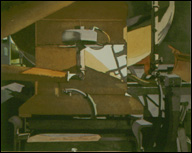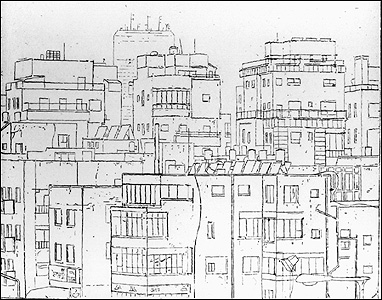![]()
Departments
Arts
![]()

|
Week of 4 December 1998 |
Vol. II, No. 16 |
Arts
Students set the stage for play with a Molière air
By Judith Sandler
Before Molière can play in Paris -- or Boston -- Jacques Cartier and his staff of SFA students first have to set the scene.
Nagle Jackson's Molière Plays Paris recounts the true story of the 1658 Paris debut of Molière's fledgling troupe l'Illustre Théâtre after years of oblivion playing in the provinces. "Their performance of Molière's farce The Love Doctor was tremendously successful," says Cartier, who is directing the Jackson play with SFA students for a run at the BU Theatre December 9 through 13. "They received royal patronage and were allowed to remain in Paris. But at this triumphant moment, when Molière should be happiest, he realizes he's enslaved by his success."
Molière Plays Paris, which was written in 1996 and produced only once, encircles two farces -- Molière's early plays The Love Doctor and The Forced Marriage -- with the drama of Molière's own life, which is cleverly reflected in the plays.
"Jackson planned for his play to be on a turntable," explains Cartier, SFA professor of theater arts. "So the audience is looking at the backstage action, and the stage revolves and we see the farces from the front; then it revolves back to the former perspective."
"Unfortunately," says scene designer Marisa Lowenstein (SFA'99), a second-year graduate student, "putting the Huntington Theatre Company's turntable on stage is quite expensive, so we had to conceive of another way of achieving the effect. We decided to make the set change perspectives by flying the larger pieces -- like portals and flats -- in and out. The actors can then turn the small pieces around."
Such technical conundrums are addressed and resolved at the weekly production meetings, which began in early September. "In our first meeting," says Lowenstein, "Jacques explained to all the designers how he envisioned the production -- the period, the style, and the actors' movements on stage."
"My first step was to research Molière and his acting troupe," says third-year graduate student and costume designer Jelena Vukmirovic (SFA'99), "as well as the social context and the paintings of the era, to get the right mood."
Lowenstein started drawing and showing her ideas to Cartier, "making sure," she says, "the set, costumes, and lights were using the same color palette." From her drawings she made a model of the set. "Then," says technical director Matt Bevacqua (SFA'99), "my assistant and I collaborate with Marisa to turn her designs into the actual scenery and make sure everything works and fits together."
This production is more complex than most, Bevacqua says, "because of the number of moving pieces for each scene change, the speed at which they have to move, and the difficulty of choreographing the changes."
While Bevacqua builds the set, Vukmirovic is making and borrowing costumes. Some have to be made because they're so specific to the play, she says, and some "we borrow from the Huntington and other theater companies. When we have exhausted that resource, we start renting costumes."
Following months of discussion, preparation, and construction, the set is loaded on the stage just over a week before opening night. "Once the set is in place and the lights hung and the actors and director move out of the rehearsal space onto the stage," says lighting designer Matt Terry (SFA'99), a third-year graduate student, "then we start the tech process." He has a good idea of the play, set, costumes, and color palettes from attending the weekly production meetings and watching rehearsals. "But I am still in the theoretical realm right up until the very end. When the company hits the stage is when I go to work."
For sound designer Michael de Almeida (SFA'00), a first-year graduate student, tech week is also an intense time. "That's when we make all our changes and adjustments," he says. "It's as if we're building a puzzle. We know what the colors and shapes are, but we don't know how they'll fit. When we finally put everything together on stage, we find that some don't quite fit."
The Boston University Theatre Arts Division presents Molière Plays Paris, directed by Jacques Cartier, December 9 to 12 at 8 p.m. and December 13 at 2 p.m. at the Boston University Theatre. For tickets and information, call 266-0800.
|
|
Sidney Hurwitz's 16" x 20"
etching Mixer,
1994 is drawn from a
cement mixing truck parked outside the BU School of
Management during the building's construction.
|
Holiday benefit sale of works by SFA artists at bargain-basement prices
By J. Nicole Long
Looking for a way to contribute to a good cause and shorten the gift list this holiday season?
A variety of original work -- from charcoal drawings to metal sculpture -- will be on display and available for purchase at the Fuller Gallery, 808 Commonwealth Ave., during the School for the Arts Exhibition and Sale from December 11 through 13. Proceeds benefit the Friends of the Arts Fund, which supports visiting artists, library acquisitions, scholarships, facility improvements, and the purchase of materials for the SFA Visual Arts Division.
As the host of the exhibition, the SFA Alumni Association is dedicating the show to alum-nus and artist Douglas Parker (SFA'66), who worked as a graphic designer for the University for more than 20 years. In 1980 he opened the Vineyard Studio/Gallery, a nonprofit gallery that promoted emerging artists. Before his death this past July, Parker encouraged the Alumni Association to sponsor the event.
SFA Teaching Associate Sam Lacombe (SFA'88,'90), one of the exhibition's organizers, says that Parker "envisioned a financially successful show that would exhibit current works being done at the University and by artists who had their beginnings here." Lacombe is donating a photo-realist painting entitled Universal, 1998. He is one of more than 100 faculty, alumni, and students from around the country who have donated over 250 works of art to the exhibition. With prices ranging from $75 to $3,200, experienced collectors can buy works by artists who have exhibited in major museums, and beginning collectors will find affordable works by emerging artists.
|
|
|
While in Tel Aviv, John Moore
first rendered this cityscape as a painting. After
he returned to the United States, he remade the
image as this black-and-white etching, titled
TA.
|
SFA Professor Sidney Hurwitz is donating two etchings, both derived from local images. Mixer is a color etching of a concrete mixing truck. "It's a rendering of the rear of the truck that was parked in front of the School of Management while it was being built," he says. Coal Dock, a monochrome etching printed in dark brown, is drawn from a power plant's coal storage building, a structure that was on the Boston waterfront until its demolition 20 years ago.
A prominent international artist who has exhibited in major museums around the world, SFA Professor John Walker is also contributing two etchings, both from a series entitled Passing Bells. Associate Professor Alston Purvis, Visual Arts Division director ad interim and graphic designer, is among the distinguished contributors as well, donating a collage. Student work includes paintings, mixed media sculpture, silk screens, and charcoal drawings.
For more information about the exhibit and sale, call 617-353-7294.

